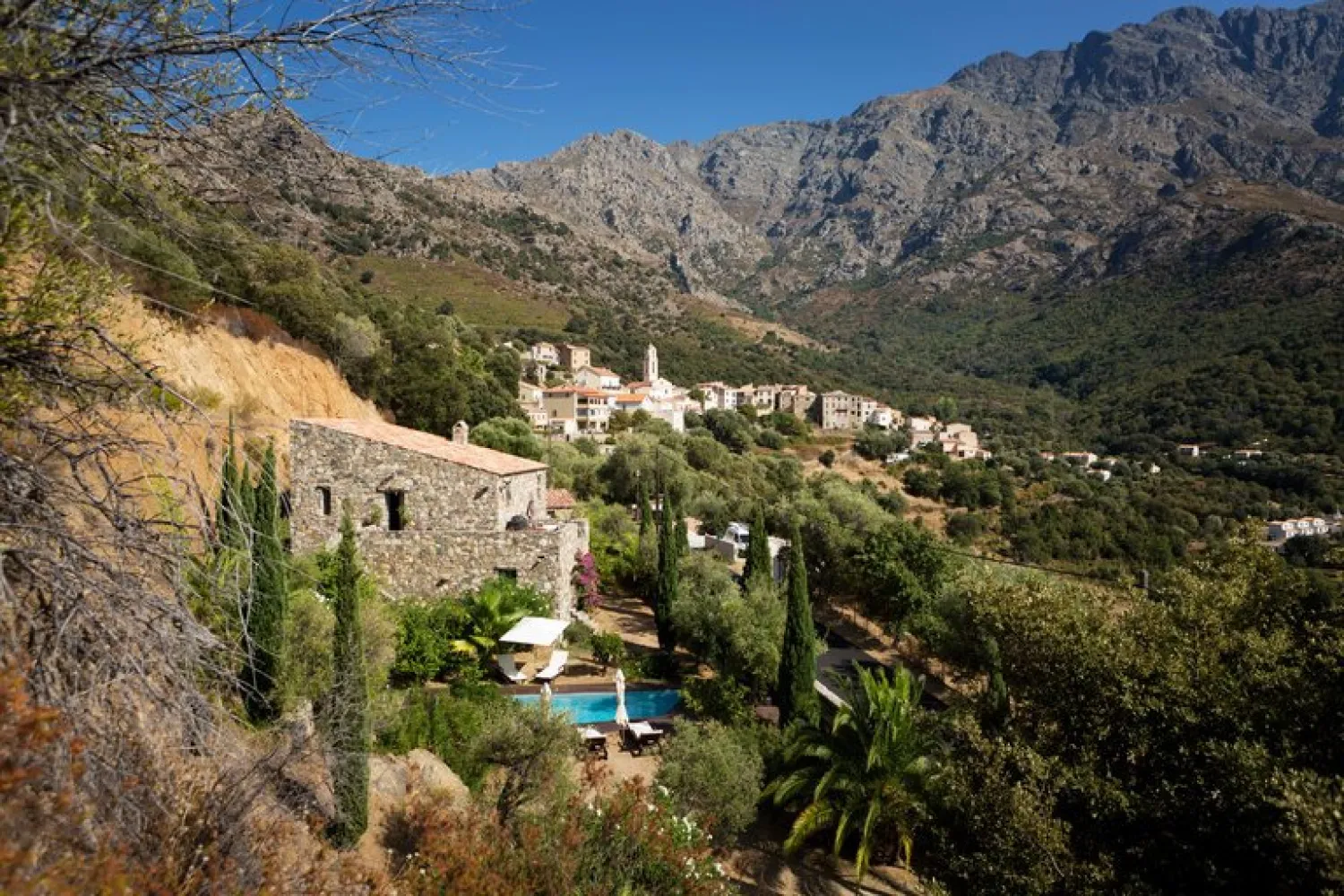Corsica- This two-story stone villa with a roof terrace sits in the rocky hills of northern Corsica, a French island. The 2,152-square-foot home was constructed in 2008 on a lot of more than half an acre and has three bedrooms and three bathrooms. The property includes a swimming pool with a wooden deck, along with a 323-square-foot stone building used for storage that could be converted to a master suite, said Frédéric Olivieri, the listing agent with Sotheby’s International Realty.
The home — which was designed by Marc Held, a French architect, with his son Mathias, the homeowner — was inspired by vernacular Corsican architecture. Made of local stone, it has an austere look, with a sloped roof and small, traditional Corsican windows with interior shutters; inside, the ceilings are high, with painted wooden beams. All three airy bedrooms are off the ground-floor entrance, each with painted wood floors and its own en-suite bathroom. A wooden staircase ascends to the second floor, which has a large living room with a wood-burning fireplace and an open kitchen with an island and oak cabinets. A large roof terrace, reached by an exterior staircase, offers views of Monte Grosso. The villa is air-conditioned and has parking, but no garage.
The property is in Zilia, a village of about 300 with vineyards and a mineral spring. Landscaped with palm, citrus and olive trees, the villa is about 15 minutes from Algajola beach and less than half an hour from the coastal city of Calvi, which has about 5,400 residents and an international airport. Ajaccio, the capital of Corsica, has a population of more than 68,000 and is about three hours away.
Market Overview
Corsica, a Mediterranean island with about 330,000 residents, is known for its stunning beaches and is essentially divided into two housing markets, in the north and south, said Lionel Thomas, the founder and real estate director of the brokerage and advisory agency Mr. & Mrs. Thomas Private Office.
“The pricing is more expensive on the south side of the island, where there are more celebrities, and it’s more fashionable than the north,” Mr. Thomas said, whereas the northern side has “less construction, more historic buildings” and is “a bit more windy and colder in the winter.”
The price of waterfront properties in both areas has increased dramatically over the past decade, but the general housing market has faced challenges following events like the global financial crisis of 2008 and, more recently, Brexit and the French presidential election, brokers said.
“Corsica, and the whole of the French market, has been a tough one for the last few years,” said Alexandra Connolly, director of Alexandra Lloyd Properties, a real estate agency based in Nice that specializes in properties on the French coast and Corsica.
But while the housing market may be sluggish, prices significantly lower than those of comparable homes on the French Riviera may draw some buyers, agents said. “We recently sold a 300-square-meter waterfront home near Porto-Vecchio, with its own beach, for 5 million euros,” Mr. Olivieri said. “A similar offer on the Riviera would be hard to find and would at least cost double the price.”
Average prices in Corsica’s population centers are wide ranging, said Claudia Mura, a director with Barnes International Realty Corsica. In Bastia, in the north, the average is roughly 2,400 euros a square meter, or $265 a square foot, she noted, while in Lecci, to the south, the average is about 4,900 euros a square meter, or $542 a square foot. And waterfront properties in cities like Lecci, Bonifacio and Porto-Vecchio in the south can be more than 20,000 euros a square meter, or $2,211 a square foot, Ms. Mura said.
Who Buys in Corsica
The housing market is mostly fueled by French buyers, including many expatriates, brokers said. But the number of foreign buyers is growing, many of them from Belgium, Switzerland, Britain, Italy, Germany, the United States, Holland and the Scandinavian countries.
Buying Basics
There are no restrictions on foreign buyers in Corsica, which is an administrative region of France. As in mainland France, a notary typically conducts the sale and a lawyer is not necessary, brokers said.
Buyers pay about 7 percent of the sale price in fees, which include the notary fee and any government taxes, Ms. Connolly said.
Mortgages are available to foreign buyers, though depending on circumstances, they may have to put down 35 to 40 percent rather than the 25 percent required of local buyers, Mr. Thomas said.
Languages and Currency
French, Corsican; euro (1 euro = $1.19)
Taxes and Fees
The annual property taxes on this home are about 4,000 euros, or $4,760.
The New York Times









